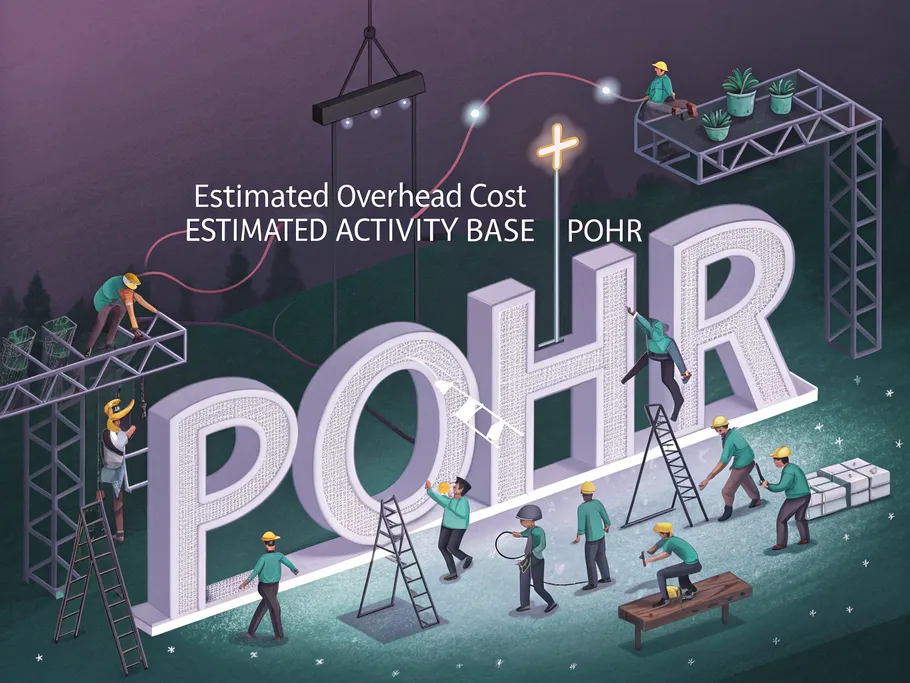That Time a Bad Guess Cost You a Contract
Ever bid on a job, win it, and then realize you’re actually losing money on the deal? It’s a special kind of hell.
Imagine a small manufacturing firm, hustling for a major contract. They base their price on the obvious stuff – direct materials and labor – then sprinkle on a random, feel-good percentage for all the other costs. You know, the boring things like factory rent, electricity, and the salary of that supervisor who mostly just walks around looking concerned.
They won the bid. High-fives all around. But as the project chugged along, the real-world costs of those “other things” started piling up, quickly blowing past their casual estimate. The firm finished the contract, but at a significant loss. Cash flow got tight, and suddenly, the company’s future looked a lot less certain.
This isn’t just a scary story; it’s a cautionary tale about the critical need for a systematic way to handle indirect cost allocation. Without a solid plan, you’re just gambling. You risk underpricing your work, killing your profitability, and making strategic decisions with all the foresight of a squirrel crossing a highway.
Understanding the POHR: Your Financial Crystal Ball
So, What Exactly is a Predetermined Overhead Rate?
A predetermined overhead rate (POHR) is a simple but powerful tool used in cost accounting. It’s an allocation rate that lets you assign those tricky indirect manufacturing costs to your products before the accounting period even starts.
You calculate it at the beginning of the year based on a smart guess – an estimate – of your future overhead costs and your expected activity levels. This allows you to figure out your production costs on the fly, rather than waiting until all the actual bills are in.
Think of it as applying a standardized slice of your indirect costs to every single thing you produce. It’s the opposite of waiting until the year is over to tally up the actual costs, which is about as helpful as getting the lottery numbers after the draw.
Why POHR is a Strategic Game-Changer
Mastering your POHR is crucial for a couple of big reasons:
- Accurate Cost Estimation: When you know your true overhead costs per product, you can price your bids competitively while still making sure you’re actually, you know, profitable.
- Informed Decision-Making: POHR gives you a much clearer picture of your profitability, helping you make smarter calls on pricing, production levels, and where to put your resources.
By baking reliable indirect cost estimates into your total product costing, POHR becomes the backbone of any effective growth strategy.
Why Guessing Upfront Beats Tallying Later
Estimating your overhead costs proactively is the foundation of solid budgeting and financial planning. A predetermined rate means you can price jobs and products all year long without having to wait for the final utility bills or indirect labor costs to roll in. Relying solely on these rates can lead to significant discrepancies, but it’s a necessary starting point. For instance, if a company estimates $400,000 in manufacturing overhead calculation and 20,000 direct labor hours, it sets a rate of $20 per hour. This proactive approach is vital.
This streamlines your monthly closing process by getting rid of the tedious job-by-job overhead allocation after the fact. It transforms your accounting from a reactive, history-report-generating chore into a proactive planning tool.
How to Calculate Predetermined Overhead Rate: The Formula and Steps
Breaking Down the Predetermined Overhead Rate Formula
The formula itself is refreshingly simple:
Predetermined Overhead Rate = Estimated Overhead Cost / Estimated Activity Base

Let’s unpack that:
- Estimated Overhead Cost: This is the total of all your estimated indirect manufacturing costs for the period. It’s everything except direct materials and direct labor.
- Estimated Activity Base: This is your measure of activity – think direct labor hours, machine hours, or direct labor costs. It’s the “cost driver” you believe is most responsible for making those overhead costs happen.
Choosing the Right Activity Base
This part is critical. Picking the wrong activity base is like using a spoon to chop down a tree – you’ll get somewhere eventually, but it’s gonna be messy and wrong. The base you choose should be the primary driver of your overhead costs.
- In a business where people do most of the work (labor-intensive), direct labor hours or costs are usually the best fit.
- In a highly automated factory with robots doing the heavy lifting, machine hours probably have a stronger link to costs like electricity and equipment maintenance.
Choose the metric that has the clearest cause-and-effect relationship with the overhead costs you’re allocating.
A Step-by-Step Calculation Guide
- Identify Overhead Costs: List all your indirect manufacturing costs – utilities, rent, equipment depreciation, supplies, you name it.
- Select an Allocation Base: Choose the activity base (e.g., direct labor hours, machine hours) that makes the most sense for your operations.
- Estimate Costs and Activity: Dig into historical data or create forecasts to estimate your total overhead costs and your total activity base for the upcoming period.
- Calculate POHR: Divide your estimated overhead cost by your estimated activity base. Boom.
Keep detailed records of your assumptions and data. It provides transparency and makes future analysis way easier.
Checking Your Work with Historical Data
At the end of the period, you have to compare the overhead you applied using your POHR to the actual overhead costs you incurred. The difference is called an overhead variance (either underapplied or overapplied).
Analyzing these variances gives you crucial feedback on how good your estimates were. This isn’t about shame; it’s about refinement. Reviewing this data helps you sharpen your forecasting for the next period, leading to a more accurate POHR and better cost control.

Predetermined Overhead Rate Examples in Action
Single-Company Scenarios
Example 1: Jotscroll Media Company estimates $500,000 in manufacturing overhead and 2,000 direct labor hours.
- POHR = $500,000 / 2,000 = $250 per direct labor hour
Example 2: ABC Ltd estimates $155,000 in manufacturing overhead and 1,200 direct labor hours.
- POHR = $155,000 / 1,200 = $129 per direct labor hour
Example 3: ABC Inc estimates $565,000 in manufacturing overhead and 8,500 direct labor hours for new product X.
- POHR = $565,000 / 8,500 = $66.47 per direct labor hour
Competitive Analysis: ABC vs. XYZ
Two companies, ABC and XYZ, are competing for the same project. ABC has $701,279 in estimated overhead and 4,000 direct labor hours. XYZ has $702,268 in estimated overhead and 3,750 direct labor hours.
- ABC Company POHR = $701,279 / 4,000 = $175.32 per direct labor hour
- XYZ Company POHR = $702,268 / 3,750 = $187.27 per direct labor hour
ABC’s lower POHR gives it a competitive edge. It suggests they are more efficient at managing their indirect costs relative to their production, allowing them to bake less overhead into their bids while still hitting their profit targets.
Applying These Examples to Your Business
To translate this to your world, map out your own cost structure. Identify your total estimated overhead and select the activity base that fits your operations best. The math is the same whether you’re a two-person shop or a massive factory; the key is making sure your estimates are as realistic as possible.
The Good, The Bad, and The Ugly of POHR
Key Advantages of Using POHR
- Streamlined Bookkeeping: It massively simplifies your closing process because you don’t have to wait to compile actual overhead costs before costing jobs.
- Expense Monitoring: It provides a benchmark for tracking expenses and spotting potential cost overruns before they become disasters.
- Pricing Accuracy: It helps you set prices that cover all your costs, both direct and indirect, ensuring you’re actually profitable.
Potential Limitations and Risks
Trusting your business decisions to ‘estimated’ overhead? Congrats, you’re building your empire on a foundation of “maybe” and “oops.”
- Inaccurate Estimates: Your POHR is only as good as your estimates. If they’re garbage, so is your rate.
- Faulty Decisions: A bad POHR can lead to flawed decisions on sales and production, causing unexpected losses.
- Variance Issues: Big gaps between your estimated and actual overhead can distort your inventory values and profit reporting.
Mitigating Risks Through Constant Vigilance
You can manage these risks with a simple, powerful habit: continuous review. This means regularly analyzing the variance between your applied overhead and your actual overhead.
Integrate these findings into your quarterly financial reviews. Be ready to adjust your rate if needed. And for God’s sake, talk to your operations and production teams to help refine your estimates. This turns POHR from a source of flawed data into a sharp, relevant tool.

Implementing POHR in Your Organization
Best Practices for Getting Started
- Team Up: Involve a cross-functional team – finance, operations, production – to estimate costs and select the activity base. More brains are better than one.
- Use Technology: Leverage your accounting software or ERP system to automate the POHR calculation and application. Work smarter, not harder.
- Document Everything: Formally write down your assumptions, methods, and approval processes. This ensures consistency and transparency.
Ongoing Monitoring and Adjustment
- Schedule Reviews: Set up monthly or quarterly reviews to compare your actuals against your POHR estimates.
- Be Flexible: If something significant changes mid-year – a huge jump in production, a new cost structure – update your POHR.
- Learn and Adapt: Use your overhead variance reports as a tool to revise future budgets and make smarter strategic decisions.
Takeaways: Using POHR for Sustainable Growth
The predetermined overhead rate is more than just an accounting term; it’s a vital tool for estimating and controlling your indirect manufacturing costs. Yes, it relies on estimates, and estimates can be wrong.
But its power to provide timely product cost information for pricing and decision-making is indispensable. By understanding how to calculate and interpret your POHR, and by committing to a process of ongoing review and adjustment, you can make more informed decisions, boost your profitability, and build a foundation for sustainable growth.
